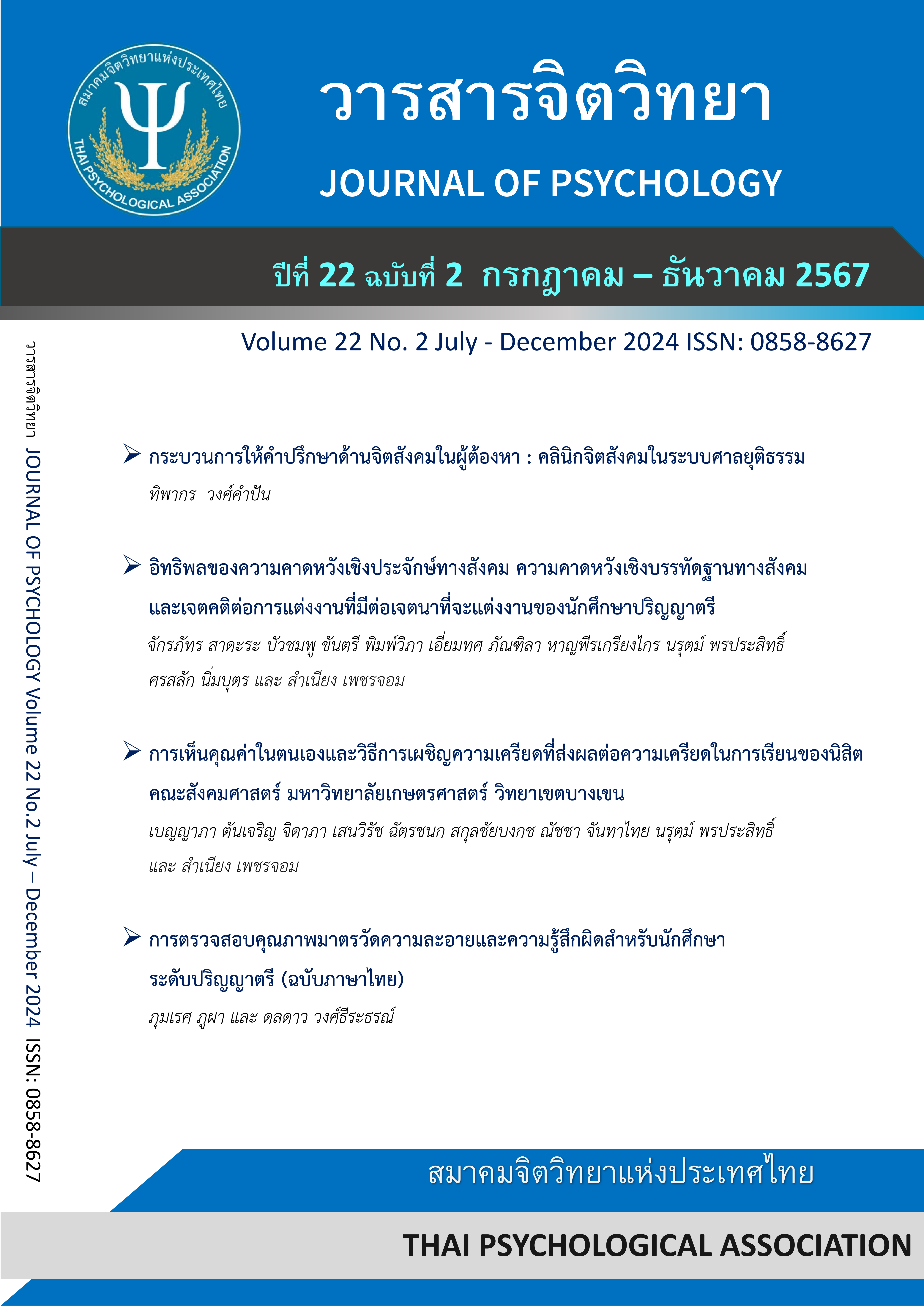การตรวจสอบคุณภาพเบื้องต้นของมาตรวัดความละอายและความรู้สึกผิดสำหรับนักศึกษาระดับปริญญาตรี (ฉบับภาษาไทย)
คำสำคัญ:
ความรู้สึกผิด, ความละอาย, นักศึกษาระดับปริญญาตรี, การตรวจสอบคุณภาพมาตรวัดบทคัดย่อ
บทคัดย่อ
การวิจัยครั้งนี้ มีวัตถุประสงค์เพื่อตรวจสอบคุณภาพเบื้องต้นของมาตรวัดความละอายและความรู้สึกผิดสำหรับนักศึกษาระดับปริญญาตรี (ฉบับภาษาไทย) มาตรวัดนี้พัฒนามาจากมาตรวัดต้นฉบับ The State Shame and Guilt Scale (SSGS) ของ Marschall และคณะ (1994) ประกอบด้วย 2 องค์ประกอบ ได้แก่ ความละอาย และ ความรู้สึกผิด กลุ่มตัวอย่างประกอบด้วยนักศึกษาระดับปริญญาตรีของมหาวิทยาลัยบูรพา ปีการศึกษา 2566 จำนวน 540 คน อายุเฉลี่ย 19.10 ปี (SD = 1.22 ช่วงอายุระหว่าง 18 ถึง 23 ปี) เครื่องมือที่ใช้ในการวิจัย ได้แก่ มาตรวัดความละอายและความรู้สึกผิด มาตรวัดความสุขเชิงอัตวิสัย ผลการวิจัยพบว่า มาตรวัดความละอายและความรู้สึกผิดสำหรับนักศึกษาระดับปริญญาตรี (ฉบับภาษาไทย) จำนวน 10 ข้อ มีค่าความเที่ยงแบบสอดคล้องภายในของมาตรวัดทั้งฉบับเท่ากับ .89 และมีค่าความเที่ยงแบบสอดคล้องภายในแยกตามรายด้านเท่ากับ .86 และ .88 ตามลำดับ ผลการตรวจสอบความตรงตามเกณฑ์สัมพันธ์กับมาตรวัดความสุขเชิงอัตวิสัย พบว่ามาตรวัดนี้ทั้งฉบับมีความสัมพันธ์เชิงเส้นตรงทางลบกับมาตรวัดความสุขเชิงอัตวิสัย (r เท่ากับ -.356, p < .01) ผลการวิเคราะห์องค์ประกอบเชิงยืนยัน พบว่า แบบจำลองมาตรวัดความละอายและความรู้สึกผิดสำหรับนักศึกษาระดับปริญญาตรี มีความสอดคล้องกับข้อมูลเชิงประจักษ์ (Chi-square = 0.42, df =3, p = 0.936, GFI = 1.00, AGFI = 0.99, RMR = 0.0144, RMSEA = 0.018) ผลการศึกษาแสดงให้เห็นว่ามาตรวัดนี้เหมาะสมสำหรับการประเมินความละอายและความรู้สึกผิดสำหรับนักศึกษาระดับปริญญาตรีได้ และสามารถนำไปใช้ในการดูแลเชิงจิตวิทยาเพื่อการลดความละอายและความรู้สึกผิดรวมถึงสร้างเสริมความสุขเชิงอัตวิสัยในนักศึกษาระดับปริญญาตรีอย่างเหมาะสม
เอกสารอ้างอิง
เอกสารอ้างอิง
Budiarto, Y., & Helmi, A. F. (2021). Shame and self-esteem: A meta-analysis. Europe's journal of psychology, 17(2), 131. https://doi.org/10.5964/ejop.2115
Caldwell, J., Meredith, P., Whittingham, K., & Ziviani, J. (2021). Shame and guilt in the postnatal period: a systematic review. Journal of reproductive and infant psychology, 39(1), 67-85.
Cavalera, C., Pepe, A., Zurloni, V., Diana, B., & Realdon, O. (2017). A short version of the State Shame and Guilt Scale (SSGS-8). TPM. TESTING, PSYCHOMETRICS, METHODOLOGY IN APPLIED PSYCHOLOGY, 24(1), 99-106.
Chis, B. K. B. (2024). How Shame, Guilt, and Religiosity Relate to Well-Being in a Limited Swedish Context.
Cohen, T. R., Wolf, S. T., Panter, A. T., & Insko, C. A. (2011). Introducing the GASP scale: a new measure of guilt and shame proneness. Journal of personality and social psychology, 100(5), 947.
Diener, E. (1984). Subjective well-being. Psychological bulletin, 95(3), 542.
Dos Santos, F. K., Maia, J. A., Gomes, T. N. Q., Daca, T., Madeira, A., Damasceno, A., ... & Prista, A. (2014). Secular trends in habitual physical activities of Mozambican children and adolescents from Maputo City. International Journal of Environmental Research and Public Health, 11(10), 10940-10950.
Ellenbogen, S., Trocme, N., Wekerle, C., & McLeod, K. (2015). An exploratory study of physical abuse–related shame, guilt, and blame in a sample of youth receiving child protective services: Links to maltreatment, anger, and aggression. Journal of Aggression, Maltreatment & Trauma, 24(5), 532-551.
Ghinassi, S., Fioravanti, G., & Casale, S. (2023). Is shame responsible for maladaptive daydreaming among grandiose and vulnerable narcissists? A general population study. Personality and Individual Differences, 206, 112122.
https://doi.org/10.1016/j.paid.2023.112122
Harder, D. H., & Zalma, A. (1990). Two promising shame and guilt scales: A construct validity comparison. Journal of personality assessment, 55(3-4), 729-745.
Landers, M., Sznycer, D., & Durkee, P. (2024). Are self-conscious emotions about the self? Testing competing theories of shame and guilt across two disparate cultures. Emotion, 24(5), 1157–1168.
Malinakova, K., Furstova, J., Kalman, M., & Trnka, R. (2020). A psychometric evaluation of the Guilt and Shame Experience Scale (GSES) on a representative adolescent sample: A low differentiation between guilt and shame. International journal of environmental research and public health, 17(23), 8901.
Marschall, D., Sanftner, J., & Tangney, J. (1994). The state shame and guilt scale (SSGS) George Mason University. Fairfax, VA.
Milan, L., & Varescon, I. (2024). Self-stigma in alcohol use disorder: Involvement of guilt and shame in the progressive model. Stigma and Health, 9(3), 294. https://doi.org/10.1037/sah0000424
Muris, P., Meesters, C., & van Asseldonk, M. (2018). Shame on me! Self-conscious emotions and big five personality traits and their relations to anxiety disorders symptoms in young, non-clinical adolescents. Child Psychiatry & Human Development, 49, 268- 278.
Novin, S., & Rieffe, C. (2015). Validation of the brief shame and guilt questionnaire for children. Personality and Individual Differences, 85, 56-59.
Pachankis, J. E., Hatzenbuehler, M. L., Klein, D. N., & Bränström, R. (2024). The role of shame in the sexual-orientation disparity in mental health: A prospective population-based study of multimodal emotional reactions to stigma. Clinical psychological science, 12(3), 486-504. https://doi.org/10.1177/21677026231177714
Punyamoonwongsa, Charunrak, et al. "Social Emotions in Students’ Learning Behaviors." Journal of Organizational Innovation & Culture 14.1 (2023): 59-75.
Sheehy, K., Noureen, A., Khaliq, A., Dhingra, K., Husain, N., Pontin, E. E., ... & Taylor, P. J. (2019). An examination of the relationship between shame, guilt and self-harm: A systematic review and meta-analysis. Clinical psychology review, 73, 101779.
Sekowski, M., Gambin, M., Cudo, A., Wozniak-Prus, M., Penner, F., Fonagy, P., & Sharp, C. (2020). The relations between childhood maltreatment, shame, guilt, depression and suicidal ideation in inpatient adolescents. Journal of affective disorders, 276, 667- 677.
Simonds, L. M., John, M., Fife-Schaw, C., Willis, S., Taylor, H., Hand, H., ... & Winton, H. (2016). Development and validation of the Adolescent Shame-Proneness Scale. Psychological assessment, 28(5), 549.
Srisongkhram, W. (2023). The Relationship between Personality Dimensions and Cyber Aggression: The Role of Cyber Addiction Mediators and the Role of Moral Emotions Moderators. Suranaree Journal of Social Science, 17(2), ID-e249819.
Sullivan, R., Green-Demers, I., & Lauzon, A. (2020). When do self-conscious emotions distress teenagers? Interrelations between dispositional shame and guilt, depressive and anxious symptoms, and life satisfaction. Canadian Journal of Behavioural Science/Revue canadienne des sciences du comportement, 52(3), 210.
Tangney, J. P. (1990). Assessing individual differences in proneness to shame and guilt: development of the Self-Conscious Affect and Attribution Inventory. Journal of personality and social psychology, 59(1), 102.
Tangney, J. P., Dearing, R. L., Wagner, P. E., & Gramzow, R. (2000). The Test of self-conscious affect–3 (TOSCA-3). George Manson University: Fairfax, VA, USA
Wu, X., Qi, J., & Zhen, R. (2021). Bullying victimization and adolescents’ social anxiety: Roles of shame and self-esteem. Child Indicators Research, 14, 769-781.
Zhou, T., Wang, Y., & Yi, C. (2018). Affiliate stigma and depression in caregivers of children with Autism Spectrum Disorders in China: Effects of self-esteem, shame and family functioning. Psychiatry Research, 264, 260-265. https://doi.org/10.1016/j.psychres.2018.03.071
หยกฟ้า อิศรานนท์. (2551). อิทธิพลของบุคลิกภาพแบบหลงตนเอง และความไม่สอดคล้องระหว่างการเห็นคุณค่าแห่งตนโดยนัย และการเห็นคุณค่าแห่งตนที่รับรู้ต่อสุขภาวะทางจิต : การวิเคราะห์อิทธิพลของตัวแปรกำกับและตัวแปรส่งผ่าน (วิทยานิพนธ์ปริญญาดุษฎีนิพนธ์, จุฬาลงกรณ์มหาวิทยาลัย). https://cuir.car.chula.ac.th/handle/123456789/21040
อธิวัฒน์ ยิ่งสูง. (2019). ความสัมพันธ์ระหว่างความละอายต่อตนเองความเมตตากรุณาต่อตนเองสติและปัญหา ด้านจิตใจของนิสิตระดับปริญญาตรี (วิทยานิพนธ์ปริญญามหาบัณฑิต, จุฬาลงกรณ์มหาวิทยาลัย). https://digital.car.chula.ac.th/chulaetd/9150/
เผยแพร่แล้ว
รูปแบบการอ้างอิง
ฉบับ
ประเภทบทความ
สัญญาอนุญาต
ลิขสิทธิ์ (c) 2025 สมาคมจิตวิทยาแห่งประเทศไทย

อนุญาตภายใต้เงื่อนไข Creative Commons Attribution-NonCommercial-NoDerivatives 4.0 International License.
บทความที่ได้รับการตีพิมพ์เป็นลิขสิทธิ์ของสมาคมจิตวิทยาแห่งประเทศไทย
ข้อความที่ปรากฎในบทความแต่ละเรื่องในวารสารวิชาการเล่มนี้เป็นความคิดเห็นส่วนตัวของผู้เขียนแต่ละท่านไม่เกี่ยวข้องกับสมาคมจิตวิทยาแห่งประเทศไทย แต่อย่างใด ความรับผิดชอบองค์ประกอบทั้งหมดของบทความแต่ละเรื่องเป็นของผู้เขียนแต่ละท่าน หากมีความผิดพลาดใด ๆ ผู้เขียนแต่ละท่านจะรับผิดชอบบทความของตนเองแต่ผู้เดียว






